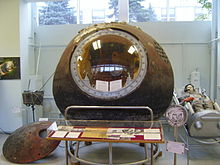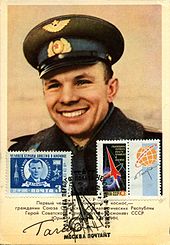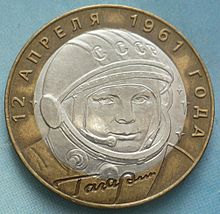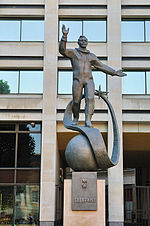
Yuri Gagarin
Did you know...
SOS Children have produced a selection of wikipedia articles for schools since 2005. Child sponsorship helps children one by one http://www.sponsor-a-child.org.uk/.
| Yuri Gagarin Юрий Гагарин |
|
|---|---|
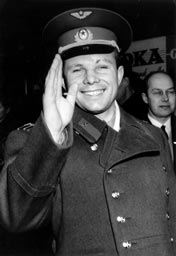 |
|
 Soviet cosmonaut The first human in space |
|
| Other names | Yuri Alekseyevich Gagarin |
| Nationality | Soviet |
| Status | Deceased |
| Born | 9 March 1934 Klushino, Russian SFSR, Soviet Union |
| Died | 27 March 1968 (aged 34) Novosyolovo, Russian SFSR, Soviet Union |
| Other occupation | Pilot |
| Rank | Colonel ( Polkovnik), Soviet Air Forces |
| Time in space | 1 hour, 48 minutes |
| Selection | Air Force Group 1 |
| Missions | Vostok 1 |
| Mission insignia | |
| Awards | |
Yuri Alekseyevich Gagarin (Russian: Ю́рий Алексе́евич Гага́рин; IPA: [ˈjʉrʲɪj ɐlʲɪˈksʲejɪvʲɪtɕ ɡɐˈɡarʲɪn]; 9 March 1934 – 27 March 1968) was a Soviet pilot and cosmonaut. He was the first human to journey into outer space, when his Vostok spacecraft completed an orbit of the Earth on 12 April 1961.
Gagarin became an international celebrity, and was awarded many medals and titles, including Hero of the Soviet Union, the nation's highest honour. Vostok 1 marked his only spaceflight, but he served as backup crew to the Soyuz 1 mission (which ended in a fatal crash). Gagarin later became deputy training director of the Cosmonaut Training Centre outside Moscow, which was later named after him. Gagarin died in 1968 when the MiG 15 training jet he was piloting crashed.
Early life
Yuri Gagarin was born in the village of Klushino near Gzhatsk (renamed Gagarin in 1968 after his death), (now in Smolensk Oblast, Russia), on 9 March 1934. His parents, Alexey Ivanovich Gagarin and Anna Timofeyevna Gagarina, worked on a collective farm. Despite being identified in reports by the word usually rendered in English as "peasant", they weren't "peasants". Anna Timofeevna was well known as a voracious reader, and Aleksej Ivanovich as a skilled carpenter. Yuri was the third of four children, and his elder sister helped raise him while his parents worked. Like millions of people in the Soviet Union, the Gagarin family suffered during Nazi occupation in World War II. After a German officer took over their house, the family constructed a small mud hut where they spent a year and nine months until the end of the occupation. His two older siblings were deported to Nazi Germany for slave labour in 1943, and did not return until after the war. In 1946, the family moved to Gzhatsk.
Career in the Soviet Air Force
In his youth, Gagarin became interested in space and planets. After studying for one year at a vocational technical school in Lyubertsy, Gagarin was selected for further training at a technical high school in Saratov. While there, he joined the "AeroClub", and learned to fly a light aircraft, a hobby that would take up an increasing amount of his time.
In 1955, after completing his technical schooling, he entered military flight training at the Orenburg Pilot's School. While there he met Valentina Goryacheva, whom he married in 1957, after gaining his pilot's wings in a MiG-15. Post-graduation, he was assigned to the Luostari airbase in Murmansk Oblast, close to the Norwegian border, where terrible weather made flying risky. He became a Lieutenant in the Soviet Air Force on 5 November 1957; on 6 November 1959 he received the rank of Senior Lieutenant.
Career in the Soviet space program
Selection and training
In 1960, after much searching and a selection process, Yuri Gagarin was chosen with 19 other pilots for the Soviet space program. Gagarin was further selected for an elite training group known as the Sochi Six, from which the first cosmonauts of the Vostok programme would be chosen. Gagarin and other prospective candidates were subjected to experiments designed to test physical and psychological endurance; he also underwent training for the upcoming flight. Out of the twenty selected, the eventual choices for the first launch were Gagarin and Gherman Titov due to their performance during training sessions as well as their physical characteristics — space was limited in the small Vostok cockpit, and both men were rather short. Gagarin was 1.57 metres (5 ft 2 in) tall.
In August 1960, when Gagarin was one of 20 possible candidates, an Air Force doctor evaluated his personality as follows:
[M]odest; embarrasses when his humor gets a little too racy; high degree of intellectual development evident in Yuriy; fantastic memory; distinguishes himself from his colleagues by his sharp and far-ranging sense of attention to his surroundings; a well-developed imagination; quick reactions; persevering, prepares himself painstakingly for his activities and training exercises, handles celestial mechanics and mathematical formulae with ease as well as excels in higher mathematics; does not feel constrained when he has to defend his point of view if he considers himself right; appears that he understands life better than a lot of his friends.—Soviet Air Force doctor,
Gagarin was also a favoured candidate by his peers. When the 20 candidates were asked to anonymously vote for which other candidate they would like to see as the first to fly, all but three chose Gagarin. One of these candidates, Yevgeny Khrunov, believed that Gagarin was very focused, and was demanding of himself and others when necessary.
Gagarin kept physically fit throughout his life, and was a keen sportsman. Cosmonaut Valery Bykovsky wrote:
Service in the Air Force made us strong, both physically and morally. All of us cosmonauts took up sports and PT seriously when we served in the Air Force. I know that Yuri Gagarin was fond of ice hockey. He liked to play goal keeper... I don't think I am wrong when I say that sports became a fixture in the life of the cosmonauts.
In addition to being a keen ice hockey player, Gagarin was also a basketball fan, and coached the Saratov Industrial Technical School team, as well as being an umpire/referee.
Vostok 1
On 12 April 1961, aboard the Vostok 3KA-3 ( Vostok 1), Gagarin became both the first human to travel into space, and the first to orbit the earth. His call sign was Kedr ( Cedar, Russian: Кедр).
In his post-flight report, Gagarin recalled his experience of spaceflight, having been the first human in space:
The feeling of weightlessness was somewhat unfamiliar compared with Earth conditions. Here, you feel as if you were hanging in a horizontal position in straps. You feel as if you are suspended.
Following the flight, Gagarin told the Soviet leader Nikita Khrushchev that during reentry he had whistled the tune "The Motherland Hears, The Motherland Knows" (Russian: "Родина слышит, Родина знает"). The first two lines of the song are: "The Motherland hears, the Motherland knows/Where her son flies in the sky". This patriotic song was written by Dmitri Shostakovich in 1951 (opus 86), with words by Yevgeniy Dolmatovsky.
Some sources have claimed that Gagarin commented during the flight, "I don't see any God up here." However, no such words appear in the verbatim record of his conversations with Earth-based stations during the spaceflight. In a 2006 interview, Gagarin's friend Colonel Valentin Petrov stated that the cosmonaut never said such words, and that the quote originated from Nikita Khrushchev's speech at the plenum of the Central Committee of the CPSU about the state's anti-religion campaign, saying "Gagarin flew into space, but didn't see any god there." Petrov also said that Gagarin had been baptised into the Orthodox Church as a child, and a 2011 Foma magazine article quoted the rector of the Orthodox church in Star City saying, "Gagarin baptized his elder daughter Elena shortly before his space flight; and his family used to celebrate Christmas and Easter and keep icons in the house."
After Vostok 1
After the flight, Gagarin became a worldwide celebrity, touring widely abroad. He visited Italy, Germany, Canada, Brazil, Japan, Egypt and Finland to promote the Soviet Union's accomplishment of putting the first human in space. He visited the United Kingdom three months after the Vostok 1 mission, visiting the cities of London and Manchester, the latter of which has been fondly remembered by locals.
The attention of female fans took a toll on his marriage. Gagarin supposedly jumped out of the second floor window and hit his face on a kerbstone, which resulted in a deep cut above his left eye. The scar remained visible after the incident.
In 1962, he began serving as a deputy to the Supreme Soviet of the Soviet Union. He later returned to Star City, the cosmonaut facility, where he spent seven years working on designs for a reusable spacecraft. He became Lieutenant Colonel (or Podpolkovnik) of the Soviet Air Force on 12 June 1962 and on 6 November 1963 he received the rank of Colonel ( Polkovnik) of the Soviet Air Force. Soviet officials tried to keep him away from any flights, being worried of losing their hero in an accident. Gagarin was backup pilot for his friend Vladimir Komarov in the Soyuz 1 flight, which was launched despite Gagarin's protests that additional safety precautions were necessary. When Komarov's flight ended in a fatal crash, Gagarin was permanently banned from training for and participating in further spaceflights.
Gagarin had become deputy training director of the Star City cosmonaut training base. At the same time, he began to re-qualify as a fighter pilot.
Death
On 27 March 1968, while on a routine training flight from Chkalovsky Air Base, he and flight instructor Vladimir Seryogin died in a MiG-15UTI crash near the town of Kirzhach. The bodies of Gagarin and Seryogin were cremated and the ashes were buried in the walls of the Kremlin on Red Square. Gagarin was survived by his wife Valentina, and daughters Elena and Galina. Elena Gagarina, Yuri's elder daughter, is an art historian who has worked as a director-general of the Moscow Kremlin Museums since 2001. His younger daughter, Galina, is department chair at Plekhanov Russian Economic University in Moscow.
Cause of jet crash
The cause of the crash that killed Gagarin is not entirely certain, and has been subject to speculation about conspiracy theories over the ensuing decades.
Soviet documents declassified in March 2003 showed that the KGB had conducted their own investigation of the accident, in addition to one government and two military investigations. The KGB's report dismissed various conspiracy theories, instead indicating that the actions of airbase personnel contributed to the crash. The report states that an air traffic controller provided Gagarin with outdated weather information, and that by the time of his flight, conditions had deteriorated significantly. Ground crew also left external fuel tanks attached to the aircraft. Gagarin's planned flight activities needed clear weather and no outboard tanks. The investigation concluded that Gagarin's aircraft entered a spin, either due to a bird strike or because of a sudden move to avoid another aircraft. Because of the out-of-date weather report, the crew believed their altitude to be higher than it actually was, and could not react properly to bring the MiG-15 out of its spin.
In his 2004 book Two Sides of the Moon, Alexey Leonov recounts that he was flying a helicopter in the same area that day when he heard "two loud booms in the distance." Corroborating other theories, his conclusion is that a Sukhoi jet (which he identifies as a Su-15 'Flagon') was flying below its minimum allowed altitude, and "without realizing it because of the terrible weather conditions, he passed within 10 or 20 meters of Yuri and Seregin's plane while breaking the sound barrier." The resulting turbulence would have sent the MiG into an uncontrolled spin. Leonov believes the first boom he heard was that of the jet breaking the sound barrier, and the second was Gagarin's plane crashing.
Another theory, advanced by the original crash investigator in 2005, hypothesizes that a cabin air vent was accidentally left open by the crew or the previous pilot, leading to oxygen deprivation and leaving the crew incapable of controlling the aircraft. A similar theory, published in Air & Space magazine, is that the crew detected the open vent and followed procedure by executing a rapid dive to a lower altitude. This dive caused them to lose consciousness and crash.
On 12 April 2007, the Kremlin vetoed a new investigation into the death of Gagarin. Government officials said that they saw no reason to begin a new investigation.
In April 2011, documents from a 1968 commission set up by the Central Committee of the Communist Party to investigate the accident were declassified. Those documents revealed that the commission's original conclusion was that Gagarin or Seryogin had maneuvered sharply either to avoid a weather balloon, leading the jet into a "super-critical flight regime and to its stalling in complex meteorological conditions," or to avoid "entry into the upper limit of the first layer of cloud cover".
Legacy and tributes
Legacy

Aside from his short stature at 1.57 metres (5 ft 2 in), one of Gagarin's most notable traits was his smile. Many commented on how Gagarin's smile gained the attention of crowds on the frequent tours he did in the months after the Vostok 1 mission success.
Gagarin also garnered a reputation as an adept public figure. When he visited Manchester in the United Kingdom, it was pouring rain. However, Gagarin insisted that the car hood remain back so that the cheering crowds could catch a glimpse of him. Gagarin stated, "If all these people have turned out to welcome me and can stand in the rain, so can I." Gagarin refused an umbrella and remained standing in his open-top Bentley so that the cheering crowds could still see him.
Sergei Korolev, one of the masterminds behind the early years of the Soviet space program, later said that Gagarin possessed a smile "that lit up the Cold War".
Tributes
Gagarin was also honored by the American space program during Apollo 11 when astronauts Neil Armstrong and Buzz Aldrin left a memorial satchel containing medals commemorating Gagarin and fellow cosmonaut Vladimir Komarov on the surface of the Moon. On 1 August 1971, Apollo 15 astronauts David Scott and James Irwin left the Fallen Astronaut on the surface of the Moon as a memorial to all the American astronauts and Soviet cosmonauts that died in the Space Race, with Yuri Gagarin listed among 14 others.
There were two commemorative coins issued in the Soviet Union to honour the 20th and 30th anniversaries of his flight: 1 ruble coin (1981, copper-nickel) and 3 ruble coin (1991, silver). In 2001, to commemorate the 40th anniversary of Gagarin's flight, a series of four coins bearing his likeness was issued in Russia: 2 ruble coin (copper-nickel), 3 ruble coin (silver), 10 ruble coin (brass-copper, nickel), and 100 ruble coin (silver). In 2011, Russia issued a 1,000 ruble coin (gold) and 3 ruble coin (silver) to mark the 50th anniversary of his flight.
Gagarin Raion in the Sevastopol city (Ukraine) was named after him during the Soviet Union.
In 2008, the Kontinental Hockey League named their championship trophy the Gagarin Cup.
In a 2010 Space Foundation survey, Gagarin was ranked as the #6 most popular space hero, tied with Star Trek's fictional Capt. James T. Kirk.
In January 2011, Armenian airline Armavia named their first Sukhoi Superjet 100 in Gagarin's honour.
On 14 July 2011, a copy of the Yuri Gagarin Statue from outside his former school in Lyubertsy was unveiled at the Admiralty Arch end of The Mall in London, opposite the permanent sculpture of James Cook.
50th anniversary
The 50th anniversary of Gagarin's journey into space was marked in 2011 by tributes around the world. A film entitled First Orbit was shot from the International Space Station, combining the original flight audio with footage of the route taken by Gagarin. The Russian, American, and Italian Expedition 27 crew aboard the ISS sent a special video message to wish the people of the world a "Happy Yuri's Night", wearing shirts with an image of Gagarin.
Swiss-based German watchmaker Bernhard Lederer created a limited edition of 50 Gagarin Tourbillons to commemorate the 50th anniversary of Yuri Gagarin's flight.
The launch of Soyuz TMA-21 on 4 April 2011 was devoted to the 50th anniversary of the first manned space mission.
Honours and awards
- This article incorporates information from the Russian Wikipedia.
- Hero of the Soviet Union (14 April 1961)
- Pilot-Cosmonaut of the USSR (27 June 1961)
- Hero of Socialist Labour (Czechoslovak Socialist Republic, 29 April 1961)
- Hero of Socialist Labour, (People's Republic of Bulgaria, 24 May 1961)
- Hero of Labour, (Democratic Republic of Vietnam, 28 April 1962)
- President of the Soviet-Cuban friendship
- Honorary Member of the Society, "the Finland-Soviet Union"
- Honorary member of the International Academy of Astronautics (1966)
- Honored Master of Sports of the USSR (1961, title obtained as a reward for a space flight)
- Military Pilot 1st Class (1961, awarded the qualification of space flight)
- Honorary suvorovets (Moscow Suvorov Military School, 1962)
- Order of Lenin (USSR, 14 April 1961)
- Order of Georgi Dimitrov (Bulgaria, 24 May 1961)
- Order of the Star, 2nd Class (Indonesia, 10 June 1961)
- Cross of Grunwald, 1st class (Poland, 20 June 1961)
- The first Commander of the Order "Playa Giron" (Cuba, 18 July 1961)
- "For achievements in aeronautics" (Brazil, 2 August 1961)
- Order of the Flag of the Hungarian Republic, 1st class with diamonds (Hungary, 21 August 1961)
- Order of Karl Marx (German Democratic Republic, 22 October 1963)
- Order of Klement Gottwald (Czechoslovak Socialist Republic)
- Order of the Nile (Egypt, 31 January 1962)
- Order of the African Star (Liberia, 6 February 1962)
- Order of the Southern Cross (Brazil, 3 August 1961)
- Jubilee Medal "40 Years of the Armed Forces of the USSR" (USSR, 1958)
- Jubilee Medal "Twenty Years of Victory in the Great Patriotic War 1941-1945" (USSR, 9 May 1965)
- Medal "For Impeccable Service", 3rd class (Soviet Union, March 1966)
- Jubilee Medal "50 Years of the Armed Forces of the USSR" (USSR, January 1968)
- Konstantin Tsiolkovsky Gold Medal "for outstanding work in the field of interplanetary communications" (USSR)
- Medal of de Lavaux (FAI)
- Gold Medal of the Austrian Government, 1962
- Gold medal and diploma "Man in Space," the Italian Association of Space
- Gold Medal "For outstanding difference" and the Royal Aero Club Diploma, Sweden
- Gold Medal of the British Society for interplanetary travel, 1961
- Medal of Columbus (Italy)
- Gold Medal of Saint-Denis (France)
- Gold Medal Award "for courage" of the Fund Matstsotti (Italy), 2007
and others.
Yuri Gagarin was elected an honorary citizen of the cities of Kaluga, Novozybkov, Novocherkassk, Lyubertsy, Sumqayit, Smolensk, Vinnytsia and Sevastopol, Saratov, Komsomolsk-on-Amur, Tyumen (the USSR), Orenburg (Russia), Sofia, Pernik, Plovdiv (Bulgaria), Athens (Greece), Famagusta, Limassol (Cyprus), Saint-Denis (France), and Teplice (Czech Republic). He was also awarded the golden keys to the gates of the city of Cairo and Alexandria (Egypt).
